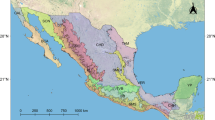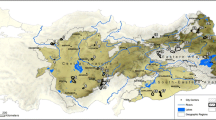Abstract
Diverse tools and approaches are currently utilized to propose conservation strategies for ecosystems, areas and individual taxa. Here, ecological niche-based modeling, identification of areas of endemism, and diverse methods to determine conservation status are carried out to detect endangered species in Selenicereus. This genus in the Cactaceae has epiphytic species that are known for their edible fruit, called pitahayas or dragon fruit. With the exception of two species (S. grandiflorus and S. undatus), the other 21 studied species in Selenicereus were identified as threatened. Unique ecological niches were identified for these species, with implications for conservation. The most significant areas of species richness and endemism occur in Central America in unprotected areas, followed by other important regions in southern Mexico, which in contrast lie within reserves. Seasonal climates are characteristic of Selenicereus species commonly distributed in seasonally tropical dry forests and coastal vegetation, in areas in Central America where land transformation is rampant.





Similar content being viewed by others
References
Aguirre-Gutiérrez J, Serna-Chávez HM, Villalobos-Arambula AR, Pérez de la Rosa JA, Raes N (2015) Similar but not equivalent: ecological niche comparison across closely-related Mexican white pines. Divers Distrib 21:245–257
Allouche O, Tsoar A, Kadmon R (2006) Assessing the accuracy of species distribution models: prevalence, Kappa and the True Skill Statistic (TSS). J Appl Ecol 43:1223–1232
Almeida GOJ, de Souza LA, Sartori-Paoli AA, Davis AR, Cota-Sánchez JH (2018) Pericarp development in fruit of epiphytic cacti: implications for fruit classification and macro-morphology in the Cactaceae. Botany 96:621–635
Andrade JL, Rengifo E, Ricalde MF, Simá JL, Cervera JC, Vargas-Soto G (2006) Microambientes de luz, crecimiento y fotosíntesis de la pitahaya (Hylocereus undatus) en un agrosistema de Yucatán. Agrociencia 40:687–697
Anna S, del Conde JH, Contreras-Medina R, Luna-Vega I (2009) Biogeographic analysis of endemic cacti of the Sierra Madre Oriental. Biol J Linn Soc 97:373–389
Aquino D, Moreno-Letelier A, González-Botello MA, Arias S (2020) The importance of environmental conditions in maintaining lineage identity in Epithelantha (Cactaceae). Ecol Evol 11:4520–4531
Bachman S, Moat J, Hill AW, de la Torre J, Scott B (2011) Supporting Red List threat assessments with GeoCat: geospatial conservation assessment tool. Zookeys 150:117–126
Barthlott W, Burstedde K, Geffert JL, Ibisch PL, Korotkotkova N, Miebach A, Rafiqpoor MD, Stein A, Mutke J (2015) Biogeography and biodiversity of Cacti.Schumannia 7:1–205
Bauer R (2003) A synopsis of tribe Hylocereeae F. B. In: Cactaceae Systematics Initiatives. Ed D. Hunt. Milborne Port, England
Bivand R, Keit TH, Rowlingson B, Pebesma E, Summer M, Hijmans R and Rouault E (2016) rgdal: Bindings for the geospatial data abstraction library. R package version 1.1–10. https://cran.r-project.org/web/packages/rgdal/index.htm. Accessed: 20 February 2019
Brittingham HA, Koshi MH, Ashman TL (2018) Higher ploidy is associated with reduced range breadth in the Potentilleae tribe. Am J Bot 105:700–710
Broennimann O, Fitzpatrick MC, Pearman PB, Petitpierre B, Pellissier L, Yoccoz NG, Thuiller W, Fortin MJ, Randin C, Zimmermann NE, Graham CH, Guisan A (2012) Measuring ecological niche overlap from occurrence and spatial environmental data. Glob Ecol Biogeogr 21:481–497
Costa GC, Nogueira C, Machado RB, Colli GR (2010) Sampling bias and the use of ecological niche modeling in conservation planning: a field evaluation in a biodiversity hotspot. Biodivers Conserv 1:883–899
Couvreur TLP, Pirie MD, Chatrou LW, Saunders RMK, Su YCF, Richardson JE, Erkens RHJ (2011a) Early evolutionary history of the flowering family Annonaceae: steady diversification and boreotropical geodispersal. J Biogeogr 38:664–680
Couvreur TLP, Porter-Morgan H, Wieringa JJ, Chatrou LW (2011b) Little ecological divergence associated with speciation in two African rain forest tree genera. BMC Evol Biol 11:296
Crisp MD, Laffan SW, Linder HP, Monro A (2001) Endemism in the Australian flora. J Biogeogr 28:183–198
DeClerck FAJ, Chazdon R, Holl KD, Milder JC, Finegan B, Martínez-Salinas IP, Canet L, Ramos Z (2010) Biodiversity conservation in human modified landscapes of Mesoamerica: past, present and future. Biol Cons 143:2301–2313
Devine JA, Wrathall D, Aguilar-González B, Benessiaiah K, Tellman B, Ghaffari Z, Ponstingel D (2021) Narco-degradation: cocaine trafficking’s environmental impacts in Central America’s protected areas. World Dev 144:105474
Di Cola V, Broennimann O, Petitpierre B, Breiner FT, D’Amen M, Randin C, Engler R (2017) Ecospat: an R package to support spatial analyses and modeling of species niches and distributions. Ecography 40:774–787
ESRI (2010) ArcView V. 10.0 Redlands. Environmental Systems Research Institute, Inc., California
Godoy Herrera JC (2003) Mesoamerican biological corridor: regional initiative for the promotion of forest conservation. XII World Forestry Congress, Québec, Canada https://www.fao.org/3/xii/ms15-e.htm
Goettsch B et al (2015) High proportion of cactus species threatened with extinction. Nat Plants 1:15142
Gomes-da-Silva J, Campostrini Sforza R (2021) Two centuries of distribution: detection of areas of endemism for the Brazilian angiosperms. Cladistics 37:442–458
Gómez-Hinostrosa C, Hernández HM (2000) Diversity, geographical distribution, and conservation of Cactaceae in the Mier y Noriega region, Mexico. Biodivers Conserv 9:403–418
Gómez-Hinostrosa C, Hernández HM, Terrazas T, Correa-Cano ME (2013) Studies on Mexican Cactaceae. V. Taxonomic Notes on Selenicereus Tricae Brittonia 66:51–59
Hernández H, Gómez-Hinostrosa C (2011) Areas of endemism of Cactaceae and the effectiveness of the protected area network in the Chihuahuan Desert. Oryx 45:191–200
Hernández-Hernández T, Brown JW, Schlumpberger BO, Eguiarte L, Magallón S (2014) Beyond aridification: multiple explanations for the elevated diversification of cacti in the New World. New Phytol 202:1382–1397
Hernández-Quiroz NS, Badano EI, Barragán-Torres F, Flores J, Pinedo-Alvarez C (2018) Habitat suitability models to make conservation decisions based on areas of high species richness and endemism. Biodivers Conserv 27:3185–3200
Hijmans RJ, Cameron SE, Parra JL, Jones PG, Jarvis A (2005) Very high-resolution interpolated climate surfaces for global land areas. Int J Climatol 25:1965–1978
Hijmans RJ, Van Etten J, Cheng J, Mattiuzzi M, Summe M, Greenberg JA, Lamigueiro OP, Bevan A, Racine EB, Shortridge A (2016) Raster: geographic data analysis and modeling. R package version 2.5–8. https://cran.r-project.org/web/packages/raster/index.html. Accessed: 20 February 2020
IUCN International Union for Conservation of Nature (2010) IUCN Red List Categories and criteria: version 3.1. IUCN Species Survival Commission. Gland y Cambridge. 85 pp.
IUCN (2012) IUCN Red List Categories and Criteria: Version 3.1. Second edition. Gland, Switzerland and Cambridge, UK
Jenkins CN, Chandra G (2008) Protection of mammal diversity in Central America. Conserv Biol 22:1037–1044
Kerr JT (1997) Species richness, endemism, and the choice of areas for conservation. Cons Biol 11:1094–1100
Korotkova N, Borsch T, Arias S (2017) A phylogenetic framework for the Hylocereeae (Cactaceae) and implications for the circumscription of the genera. Phytotaxa 327:1–46
Krüger O (2005) The role of ecotourism in conservation: panacea or Pandora’s box? Biodivers Conserv 14:579–600
Laffan SW, Lubarsky E, Rosauer DF (2014) Biodiverse, a tool for the spatial analysis of biological and related diversity. Ecography 33:643–647
Linder HP (2001) On areas of endemism, with an example from the African Restionaceae. Syst Biol 50:892–912
Martínez-Peralta C, Mandujano MC (2009) Saqueo en poblaciones naturales de Ariocarpus, el caso de A. agavoides. Cactáceas y Suculentas Mexicanas 54:60–62
Martorell C, Montaña DF, Ureta C, Mandujano MC (2015) Assessing the importance of multiple threats to and endangered globose cactus in Mexico: cattle grazing, looting and climate change. Biol Cons 181:73–81
Mesa-Sierra N, Laborde J, Escobar F (2020) Seasonally dry tropical forests of the Gulf of Mexico: a degraded landscape undergoing homogenization or a promising, resilient reservoir? Acta Oecologica 16:103583
Nobel PS, de La Barrera E (2004) CO2 uptake by the cultivated hemiepiphytic cactus, Hylocereus undatus. Ann Appl Biol 144:1–8
Novoa A, Le Roux JJ, Richardson DM, Wilson JRU (2017) Level of environmental threat posed by ornamental trade in Cactaceae. Cons Biol 31:1066–1075
Olmos-Lau VR, Mandujano MC (2016) An open door for illegal trade: online sale of Strombocactus disciformis (Cactaceae). Nat Conserv 15:1–9
Ortega-Baes P, Godínez-Alvarez H (2006) Global diversity and conservation priorities in the Cactaceae. Biodivers Conserv 15:817–827
Phillips SJ, Dudík M (2008) Modeling of species distributions with Maxent: new extensions and a comprehensive evaluation. Ecography 31:161–175
Phillips SJ, Anderson RP, Schapire RE (2006) Maximum entropy modeling of species geographic distributions. Ecol Model 190:231–259
Prieto-Torres DA, Nori J, Rojas-Soto OR, Navarro-Sigüenza AG (2021) Challenges and opportunities in planning for the conservation of Neotropical seasonally dry forests into the future. Biol Cons 257:109083
Prinzing A, Durka W, Klotz S, Brandl R (2001) The niche of higher plants: evidence for phylogenetic conservatism. Proc Royal Soc B 268:2383–2389
Quiroga MP, Castello L, Quipildor V, Premolli AC (2019) Biogeographically significant units in conservation: a new integrative concept for conserving ecological and evolutionary processes. Environ Conserv 46:293–301
R Development Core Team (2020) R: A language and environment for statistical computing. R Foundation for Statistical Computing, Vienna. http://www.R-project.org/
Ruiz-Domínguez C, Vovides AP, Sosa V (2019) Systematic relevance of pollen morphology in tribe Hylocereeae (Cactaceae). PhytoKeys 128:121–140
Schoener TW (1970) Nonsynchronous spatial overlap of lizards in patchy habitats. Ecology 51:408–418
Solórzano S, Dávila P (2015) Identification of conservation units of Mammillaria crucigera (Cactaceae): perspectives for the conservation of rare species. Plant Ecol Div 8:559–569
Sosa V, De-Nova JA, Vásquez-Cruz M (2018) Evolutionary history of the flora of Mexico: dry forests cradles and museums of endemism. J Syst Evol 56:523–536
Sosa V, Guevara R, Gutiérrez-Rodríguez BE, Ruiz-Domínguez (2020) Optimal areas and climate change effects on dragon fruit cultivation in Mesoamerica. J Agric Sci 158:461–470
Tel-Zur N, Abbo S, Bar-Zvi D, Misrahi Y (2004a) Genetic relationships among Selenicereus and Hylocereus vine cacti (Cactaceae): evidence from hybridization and cytological studies. Ann Bot 94:527–534
Tel-Zur N, Abbo S, Bar-Zvi D, Misrahi Y (2004b) Clone identification and genetic relationship among vine cacti from genera Hylocereus and Selenicereus based on RAPD analysis. Sci Hort 100:279–289
Thiers B (2021) Index Herbariorum: A global directory of public herbaria and associated staff. New York: New York Botanical Garden’s Virtual Herbarium. http://sweetgum.nybg.org/science/ih/. Accessed 06 January 2020
Warren DL, Glor RE, Turelli M (2008) Environmental niche equivalency versus conservatism: quantitative approaches to niche evolution. Evolution 62:2868–2883
Wiens JJ, Graham CH (2005) Niche conservatism: integrating evolution, ecology and conservation biology. Annu Rev Ecol Evol Syst 36:519–539
Willis F, Moat J, Paton A (2003) Defining a role for herbarium data in red list assessments: a case of study of Plectranthus from eastern and southern tropical Africa. Biodivers Conserv 12:1537–1552
Zettlemoyer MA, McKenna DD, Lau JA (2019) Species characteristics affect local extinctions. Am J Bot 106:547–559
Zhang L, Ouyang Z (2019) Exploring the relationships between ecological indicators to improve natural conservation planning at different scales. Forests 10:32
Acknowledgements
This research was supported by CONACYT, Mexico to V. S. (PNDP2015/1023), an M.Sc. scholarship to B.E. G-R. (CVU935962), and a Doctor of Science scholarship to C. R-D. (300231), also from CONACyT, Mexico.
Author information
Authors and Affiliations
Contributions
BEGR, VS and CRD collected and prepared the data used in the niche-based ecological modeling and proposed hypotheses and analyses. BEGR, RG and DFA performed the analyses. VS, DFA and BEGR contributed to writing the manuscript.
Corresponding author
Ethics declarations
Conflict of interest
The authors declare that they have no conflicts of interest.
Additional information
Publisher's Note
Springer Nature remains neutral with regard to jurisdictional claims in published maps and institutional affiliations.
Supplementary Information
Below is the link to the electronic supplementary material.
Rights and permissions
Springer Nature or its licensor holds exclusive rights to this article under a publishing agreement with the author(s) or other rightsholder(s); author self-archiving of the accepted manuscript version of this article is solely governed by the terms of such publishing agreement and applicable law.
About this article
Cite this article
Gutiérrez-Rodríguez, B.E., Guevara, R., Angulo, D.F. et al. Ecological niches, endemism and conservation of the species in Selenicereus (Hylocereeae, Cactaceae). Braz. J. Bot 45, 1149–1160 (2022). https://doi.org/10.1007/s40415-022-00818-z
Received:
Revised:
Accepted:
Published:
Issue Date:
DOI: https://doi.org/10.1007/s40415-022-00818-z




